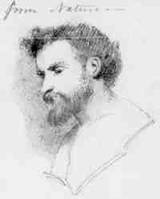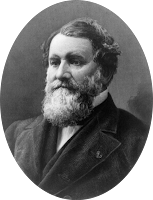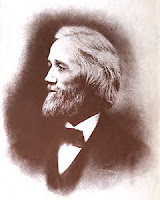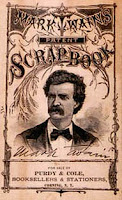This week in 19th Century American history was active in the U. S. Patent Office. I’ve thrown a couple of other inventions and “firsts” into the mix.
 |
| Morse – self-portrait |
June 20, 1840
Samuel Morse (1791-1872) patented the telegraph. Morse was born in Charlestown, MA, attended school at Philips Exeter Academy in Exeter, NH, and graduated from Yale in 1810. Although he is best known for his scientific work, his lifelong passion was for painting, and as a young man, he studied with several notable artists of his day. A skilled and prolific artist, his work includes the painting of the House of Representatives in the Rotunda of the Capitol Building in Washington, DC. In befriending a colleague lecturing at New York Athenaeum, Morse interests broadened to include electricity and its properties. He went on to study electromagnetism, which led to his development of the telegraph and the dot-dash system that became the Morse Code. After several private demonstrations of his telegraph beginning in 1837, he acquired U. S. Patent #1,647 in 1840. Four years later, in 1844, he sent his famous message “What hath God wrought?” from the Supreme Court chamber in Washington, DC, to the B&O Railroad depot in Baltimore, MD, a distance of about 45 miles. The “Victorian internet” was launched.
June 21, 1834
 |
| Cyrus Hall McCormick |
On this day, Cyrus Hall McCormick (1809-1884) of Virginia received a patent for his mechanical reaper, a device which reduced the back-breaking labor of farm hands and allowed farmers to double their crop size, and launched a national invention frenzy of labor-saving implements. McCormick was born in Rockbridge County in the Shenandoah Valley of Virginia, and had little or no formal education. He grew up working the plantation fields alongside slaves, education enough to understand the value of labor-saving devices. Despite the lack of schooling, his inventive nature sprang forth early in life, when he began inventing and improving tools and machines in his father’s plantation workshop. His father patented a few inventions, and struggled for 28 years on a functional design for the reaping machine which McCormick the younger ultimately developed and patented. Cyrus was only 25 years old upon receipt of his patent. The new reaper, using horses, replaced the use of hand-held scythes and cradles.
June 21, 1853
Dr. Russell L. Hawes (1823-1867), a physician from Worcester, MA, received a patent for an envelope-folding machine on this day. Jaded by the humdrum routine of his medical practice, he began to delve into the fascinating world of invention and mechanical devices. He applied his knowledge of human anatomy into his designs, developing a machine that fit the movements of the workers attending it. His envelope-folding machine could produce 2,500 envelopes in an hour. Prior to this invention, envelopes as a separate piece of stationery were not commonly used. The correspondent folded the letter into an envelope, keeping the blank side of one of the sheets of the letter on the outside for addressing. Upon Hawes’ invention, newer machines introduced the gummed edge and other improvements. Hawes continued both his medical and invention practices throughout his life.
Andrew Lanergan of Boston, MA, received Patent #24,468 for an improvement to the exhibition or military rocket (“bombs bursting in air”), in which the fuse was packed inside a recess in the bottom of the rocket to be drawn out when needed, thus reducing the danger of premature lighting by falling cinders or sparks.
June 22, 1832
Another physician turned inventor, Dr. John I. Howe (1793-1876) patented a machine which made wire-head pins, after having observed people making them laboriously by hand. In 1835, he founded the Howe Manufacturing Company in New York for solid-head pin production, later known as the Howe Pin Company and relocated in 1838 in Birmingham, CT, which incorporated more of Howe’s inventions and improvements. His factories spread, ultimately consolidating in Waterbury, CT, where prolific pin production continues today.
Although its origins are still disputed, the doughnut (“dough knot” – sweet dough twisted into a knot and fried in oil) is undeniably now an all-American icon. Early American references identify the doughnut by name (period cookbooks dating to 1803, a short story in a Boston newspaper in 1808, and Washington Irving in “History of New York” in 1809) , but it didn’t yet have the hole in the middle. An American by the name of Hansen Gregory claimed the invention of the O-shaped pastry in 1847, when he was only 16 years old, working on a lime-trading ship. According to one version of the story, Gregory was unhappy with the centers of doughnuts never cooking through, so he punched a hole in the middle of the lump of dough and fried it that way. Twenty-five years later, in 1872, John Blondell received a patent for the first doughnut cutter.
June 22, 1870
The boardwalk in America was invented in 1870 when luxury hotel owners in the resort town of Atlantic City, NJ, constructed the elevated walkway along the beaches to keep guests from tracking beach sand into their lobbies. Before the hurricane of 1944 destroyed much of the boardwalk, it extended over seven miles from Atlantic City to Longport, through Ventnor and Margate. Atlantic City was the inspiration for the board game “Monopoly.”
 |
| Christopher Latham Sholes |
June 23, 1868
Christopher Latham Sholes (1819-1890) , a Pennsylvania native living in Wisconsin, patented the “type-writer.” Sholes’ version was cumbersome, about the size of a desk, but it was functional. Sholes also developed the “QWERTY” keyboard pattern still in use today. The better-known Remington improved on the idea with the practical typewriter most of us are familiar with today. Sholes was a newspaper publisher by trade, and also worked extensively in the political arena. His older brother Charles was also a newspaper publisher and politician. Typewriters had been invented as early as 1714 and over the years had taken various forms; Sholes’ model was the first to be commercially successful. His initial inspiration came when his employees, the compositors at his printing press, went on strike, and he thought that a machine to typeset in their place was in order.
June 24, 1844
Charles Goodyear (1800-1860) , a native of New Haven, CT, received Patent #3,633 for vulcanized rubber on this date. In 1839, he discovered the process of stabilizing rubber latex so that the resulting products would be dry, be flexible at all temperatures, and would not melt or be sticky to the touch. An inventor at heart, his financial life ran a roller-coaster gamut – rags to riches and back to rags, partly because of his passion for invention and experimentation, partly because his health broke down before he was thirty years of age, partly because of a failure of the national economy in the panic of 1837. Through it all, he worked on his rubber experiments, finally meeting with success in 1839, when he accidentally spilled some of his liquid rubber onto a hot stove, ultimately leading to the successful development of the rubber vulcanization process we use today.
 |
| Twain’s scrap book |
June 24, 1873
Mark Twain patented a scrap book on this date. What made it different from the common scrap book of the day was that it was self-pasting. He had been collecting materials into scrap books for many years, obsessed with reviews of his performances and publications. Curiously, as of June 1885, this blank book of Mark Twain’s, with no words, sold far better than any single volume of his written work: he made $50,000 from sales of the scrap book, compared with only $200,000 from the sales of all of his other books combined at that time.
June 25, 1867
Lucien B. Smith of Kent, Ohio patented the first barbed wire, a simple concept designed to restrain cattle at minimal expense. The pain inflicted by the bristling points of the barbs discouraged ornery livestock from breaching the fences and getting into grain crops or onto railroad tracks. Especially on the plains, the shortage of wood for fencing made wire fencing quickly popular, since it made the enclosure of much larger areas feasible and affordable. Barbed wire was soon modified and adapted into so many different styles and types that there is a barbed wire museum today (Devil’s Rope Museum in McLean, TX) to exhibit all the different kinds that Smith’s invention spawned.
Twain scrap book image Courtesy Kevin Mac Donnell




